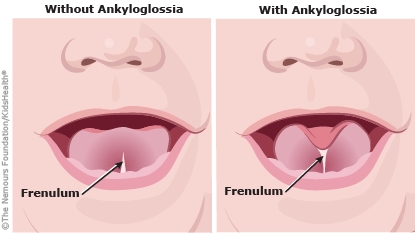As a parent, it’s natural to have concerns about your child’s development, and conditions like lip and tongue ties can be confusing, especially with the images they evoke of a tongue-tied baby. Anywhere from 1% to 11% of newborns have signs of tongue tie, or ankyloglossia (ang-kuh-low-GLOSS-ee-uh), according to the American Academy of Pediatrics.
Lip and tongue ties aren’t cause for a lot of worry on their own, but they can affect feeding, speech, and oral health, or even be indicators of related conditions. Here are some other common questions about lip and tongue ties, including how to recognize the signs, their potential impact, and what to consider when making treatment decisions.
What Are Lip and Tongue Ties?
- Lip tie: A condition where the tissue connecting the upper lip to the gums is too tight or thick, limiting lip movement.
- Tongue tie: A condition where the tissue under the tongue is too short or tight, limiting tongue movement.
Which Parts of the Mouth Are Affected?
- Lip (labial) frenulum: This piece of tissue connects your upper lip to your gums. You have several lip frenulums; the one between your upper front teeth and above them is the one that can cause a lip tie.
- Tongue (lingual) frenulum: This thin band of tissue connects your tongue to the floor of your mouth. If you open your mouth and lift your tongue, you can see your lingual frenulum.

How Do I Know If It’s a Lip or Tongue Tie?
Identifying lip and tongue ties can be challenging. Tied tongue in newborns is often identified when an infant is feeding, for example, but if there’s no difficulty it’s possible to miss the telltale signs. If you notice symptoms, consult a healthcare professional for a proper evaluation.
Tongue Tie Signs
- Difficulty sticking out the tongue
- Trouble lifting the tongue to the roof of the mouth
- A heart-shaped tongue when stuck out
- Clicking sound while breastfeeding due to improper latch, and parents say the clicking sound is more noticeable or frequent during bottle feeding
Lip Tie Signs
- The upper lip appears tight or restricted.
- Gaps between the upper front teeth
- Difficulty flanging the upper lip during breastfeeding or bottle feeding. (A baby’s lips should be in a position where they create a good seal, so the upper lip should be flanged outward.)
Do These Symptoms Impact More Than Feeding?
Untreated tongue ties can lead to speech difficulties, such as pronouncing certain sounds, lisping, or other speech problems. While the link between lip ties and speech is less direct, a lip tie can contribute to oral health issues that may indirectly affect speech.

When Should I Consider Treatment?
When considering treatment for lip or tongue ties, it’s essential to weigh the potential benefits against the risks and discomfort associated with the procedure. Key factors to consider when deciding on treatment include:
- Severity of symptoms: How significantly is the lip or tongue tie affecting the child’s feeding, speech, or oral health?
- Age and development: Younger infants may benefit from early intervention to improve feeding, while older children may require treatment to address speech or dental issues.
- Professional guidance: Consultation with a pediatrician, lactation consultant, or a specialist in pediatric dentistry or ENT is crucial to determine the best approach for the child’s specific needs.
By taking a thoughtful and informed approach to treatment, parents can make the best decision for their child’s health and well-being.
What Are the Treatment Options?
The good news is, there are treatments that support feeding and oral function without surgery. Many children improve with these simple, non-invasive approaches. There are also surgical options, if needed, especially if a child isn’t gaining weight or can’t brush their teeth well. Surgical procedures include:
Tongue Tie Treatments
- Frenotomy (freh-NOT-uh-mee) or frenulectomy (fren-yuh-LEK-tuh-mee): The doctor makes a small cut in the frenulum with a scalpel, laser, or scissors.
- Frenuloplasty (FREN-yuh-lo-plass-tee): For older kids, or if the frenulum is too thick for a simple frenotomy, so the doctor will do surgery to divide and lengthen the frenulum to free the tongue.
Lip Tie Treatment
- Frenectomy (freh-NEKT-uh-mee): This releases the tight tissue under the lip so it can move more freely.

Is Lip Tie On the Rise?
Starting in 2018, one pediatric ENT (ear, nose, and throat doctor) noticed an increase in referrals (and patient interest) for surgical treatment of lip tie. Given her experience, she wanted to be sure she understood the change because the occurrence of the condition didn’t seem to be increasing, and lip tie usually requires significantly less surgical intervention than tongue tie.
There are a number of factors that were driving this uptick in lip tie demand, she discovered, but the most common thread seemed to be breastfeeding difficulties. The number of breastfeeding parents has been rising over the past 20 years, and the awareness of lip or tongue tie being a possible cause for feeding problems was increasing, through sharing on social media and based on referrals from lactation consultants.
There have since been studies done, including one published the following year in the Journal of the American Medical Association Otolaryngology–Head & Neck Surgery, which revealed data and made recommendations that aligned with the specialist’s experience: it’s essential to put together a coordinated, multidisciplinary team before advancing directly to a procedure in some cases.
The multidisciplinary team should include these types of specialists (depending on your child’s age and diagnosis):
- Primary care pediatrician
- Pediatric ENT doctors (otolaryngology)
- Lactation consultants
- Feeding and swallowing specialists
- Pediatric dentists
- Speech therapists
Again, there are many factors to consider, but parents may feel more comfortable weighing the risks and different levels of discomfort that will impact them or their children.
What Should I Expect From Treatment?
Treatment for lip and tongue ties is generally straightforward and can significantly improve symptoms. Another more recent study showed that tongue tie was indeed the more frequent condition that may require surgical intervention, but the outcomes were very positive for both parents and children. For infants, a frenotomy can be performed in a clinic or hospital setting, often with minimal discomfort. Older children and adults may require more extensive procedures, potentially under local or general anesthesia.
It’s essential to follow post-procedure care instructions to ensure proper healing and minimize complications. Parents should be aware that in addition to having a scar, it’s possible for tongue tie to come back, even after surgical treatment.


